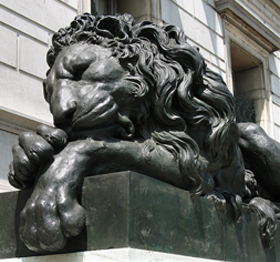Washington City Paper, Arts Desk
“The Corcoran Still Needs Permission to Dissolve Itself. Here’s Its Court Filing, Annotated.”
by Kriston Capps
Trustees of the Corcoran Gallery of Art and College of Art + Design filed a cy-près petition to the Superior Court of the District of Columbia seeking formal approval to revise the Corcoran’s federal charter. National Law Journal reporter Zoe Tillman spotted the filing yesterday. The petition would enable the Corcoran to go through with its plans to dissolve itself and be subsumed by the National Gallery of Art and George Washington University. (Catch up on the Corc issue with this backgrounder: “22 Questions for the Corcoran.”)
For the first time (and not for want of requests for comment), the Corcoran has outlined in its own words its reasoning for pursuing such a drastic solution to its problems. The entire document deserves a thorough fisking. Factually and semantically, there’s much to debate about the trustees’ reading of the situation. Officials at the University of Maryland, with whom the Corcoran pursued a deal over the course of several months before it was abruptly abandoned, come in for special treatment, for example.
Meanwhile, the trustees acknowledge that they have spent through the institution’s endowment, and indeed must “make determinations to invade the acquisition fund to maintain operations for the coming academic year.”
Two sections, in which the trustees demonstrate in two specific ways a willful misreading of their circumstances, merit special attention.
The Corcoran’s Standing Among Directors
The Corcoran’s court filing comes on the heels of scary headlines at another beleaguered museum. The Delaware Art Museum just lost its accreditation with the Association of Art Museum Directors over its decision to sell an 1868 painting by William Holman Hunt in order to pay down museum debt and replenish its endowment. In its judgment, the AAMD explains that other options were available to the Delaware Art Museum, including association help with fundraising. The judgment calls for indeterminate “sanctions,” asking members not to loan works to or collaborate on exhibits with the Delaware museum. “AAMD does not agree that the Delaware Art Museum had only two options to address its current financial challenges—sell works from the collection or close the museum,” the release reads.
Corcoran trustees dreaded running afoul of the Association of Art Museum Directors, as a lengthy passage in the cy-près petition reveals. In May, the AAMD applauded the Corcoran’s resolve to dissolve. While the Corcoran satisfied the high priests, the trustees sacrificed the body to do so.
Make no mistake: The Corcoran closed rather than take emergency measures. It is a slow-burn, graduated closure, but the Corcoran is closing. Worse, it is closing even as it committed the sin that the AAMD considers unpardonable: The museum sold the Clark Sickle-Leaf Carpet for $33.8 million in an auction of Middle Eastern and Asian rugs from the William A. Clark collection that netted the museum about $40 million. That money was never meant for future acquisitions, as the AAMD requires: By the June 2013 auction, the Corcoran had been looking to sell out for a full year. Now, whatever the Corcoran hasn’t spent from that auction purse goes to George Washington University.
From the petition:
Adherence to these [AAMD] guidelines is an essential element to maintain the Corcoran’s accreditation as a museum, which in turn assures the Corcoran’s ability to receive loans of art from other museums,
Which it can’t do closed.
attract qualified staff,
Which it can’t do closed.
participate in special and traveling exhibitions,
Which it can’t do closed.
and to maintain relationships with other museums.
Now its relationship with other museums is defined by who gets what from the Corcoran’s halls. Continuing on:
A determination by the Corcoran not to adhere to the guidelines would likely result in a loss of accreditation,
Which no longer matters (the museum violated those edicts anyway).
and would dramatically undermine the Corcoran’s reputation within the museum field,

and would likely substantially undermine its ability to recruit and retain qualified curatorial and other key museum staff,
Curators who are now clinging to one-year contracts with the National Gallery, staff who are looking at three months’ severance, adjunct instructors who have very little hope, but go on.
undercut its ability to raise funds,
More on this in a moment.
and substantially hinder if not eliminate its ability to participate in significant traveling exhibitions.
To be sure, the AAMD draws a bright line around museums treating their collections like piggy banks for good reason. Museums would destroy themselves, their histories, their legacies, and their communities if they all behaved like the Delaware Art Museum. Clearly, though, a slavish adherence to a safeguard principle isn’t always the right answer. No one thinks the Corcoran did something wrong by selling those rugs—the museum just sold them for the wrong reason.
The Corcoran’s Standing in Washington
In the petition, the trustees only partially address the institution’s dismal fundraising. The myopia they reveal is staggering. Reading on:
While the fundraising financial campaigns have produced support that has varied in amount from year to-year [sic] and purpose-to-purpose, the overall financial situation of the Corcoran has for several decades deteriorated. This deterioration is due to several factors.
What’s amazing is this passage doesn’t start with an institutional mea culpa—an apology for how the revolving door of directors, the constant bleed of knowledgeable administrators, and the alienation of key donors over the last decade ruined the Corcoran. Instead, the blame starts with D.C.:
First, the District of Columbia has lacked a substantial base of local, very wealthy donors dedicated to supporting local arts institutions, especially in comparison to other urban centers such as New York, Chicago, Los Angeles, or Philadelphia.
Arguably true in so many respects, but then, look to the Phillips Collection. Over a four-year period in which the Corcoran drew about $800,000 in contributions defined as “excess” for tax purposes—large gifts, in other words—the Phillips pulled in $23 million. Without even mounting a capital campaign.
One museum that does not merit a mention in this petition: The Phillips Collection. Instead, the Corcoran punches up:
The [National Gallery of Art] as a national institution receives federal funding support (while also seeking donations), and is open free of charge all year.
To be absolutely sure, the Corcoran is no National Gallery. It’s not a suitable comparison by any measure, except maybe longevity (the Corcoran is older).
Its location on the National Mall, its prestige as a national institution, and its greater funding resources, have undercut the Corcoran’s separate role as a museum within the District.
So how does the Phillips thrive on a residential street off Dupont Circle?
This effect has been compounded by the multiplication of Smithsonian and National Gallery–related specialist museums (e.g., the National Museum of American Art, the National Portrait Gallery, the Freer Gallery, and The Hirshhorn among others),
Brief sidebar: The Smithsonian American Art Museum, as it is known today, was called the “National Museum of American Art” between 1980 and 2000. That museum has gone by a lot of names. In fact, back when it was called the “National Institute,” and after its home at the Smithsonian Castle suffered a fire in 1865, Smithsonian stakeholders wound up lending artworks to the Corcoran for a time that stretched to several decades. Which just goes to show that the Corcoran has been around for a very, very long time. Its history dwarfs that of upstarts like the Hirshhorn. Its successes made other art museums possible.
History notwithstanding, research from the University of Chicago has indicated that even when museums expand within a single region, the spillover effects are not clear one way or another (positive or negative). It is not a given that the National Gallery thrives at the expense of the Corcoran.
Reading on:
all of which are open free-of-charge and are located on or close to the National Mall and in the area between the White House and the Capitol, thus establishing a major tourism nexus that is directed away from the Corcoran’s location west of the White House.
There are a lot of points worth considering when thinking about the future of the Corcoran: The costs it would take to bring the museum up to Americans with Disabilities Act compliance, the variable estimates for renovating the 19th-century Beaux-Arts building, the judgment the Corcoran showed in selling or mortgaging all its other properties. But this singular point—that a location within a stroller’s distance of the White House is a dead end—has always rankled the most.
For all intents and purposes, here’s the kicker to the saga:
Last, the Corcoran’s longstanding close relationship between the College and the Gallery has imposed the expenses of both, while hindering the development of a unique identity for either.
Yes, that’s right: In the end, the trustees of the Corcoran blame the museum and the college.
Read the Corcoran’s petition at the bottom of the original article here.




